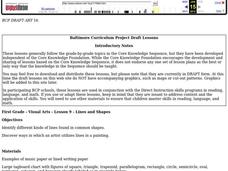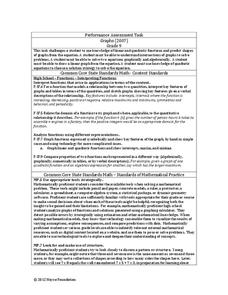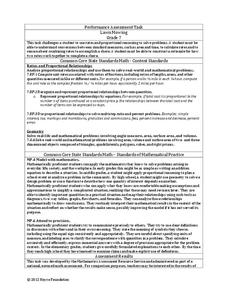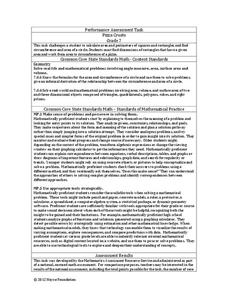Curated OER
Reflections
Students are given materials with various textures and light sources to investigate specular reflection, diffuse, reflection, angle of incidence, and angle of reflection. Students draw and label an everyday scenario showing specular and...
Curated OER
Making Patterns
Students utilize skittles and unifix cubes to practice the recognition and creation of a variety of patterns. The created patterns are copied onto sheets and the colors are labeled.
Curated OER
La Mochila (The Backpack)
Middle schoolers examine objects, labeled in Spanish, that are common items found in a backpack. They write simple sentences in Spanish listing the items from the backpack.
Curated OER
Foreign Language Initial Reading
Students match sentences and phrases to pictures in a target language. They identify the proper written form of familiar spoken phrases. Students practice labeling objects and pictures with the proper greeting, color, number or object...
Curated OER
Remembrance of Yours--Analyzing Characters Using Mementos
Students choose two characters in Hamlet and symbolize the characters with an object, or find an object that the characters might carry. In this Hamlet lesson, students find an object to represent each character they choose. The object...
Curated OER
What Do Parts Do?
Learners review the components of the scientific inquiry method. In groups, they identify and describe the components and functions of all of the parts of a plant. Using a diagram, they label the parts of the plant chosen and share...
Curated OER
Measuring Density
Students explore the concept of density. They use the the formula Density = Mass/Volume, one can determine where certain liquids and objects will settle in a graduated cylinder. In addiiton, they design a process to separate the liquids.
Curated OER
Sorting "Good" Junk (Recycling)
Second graders study recycling. In this environment lesson, 2nd graders discuss how to sort trash, sort actual trash labeling it, and explore the trash writing new uses of each item of trash instead of throwing the...
Curated OER
It's a 3-D World Out There!
Learners construct polygons. They identify attributes of three-dimensional shapes. Students name common three-dimensional shapes. They draw three-dimensional shapes, and sort three-dimensional shapes. Learners use K'NEX materials sets to...
Curated OER
Sustainable Southern Belize: Coral Health Lesson Plan
Fifth graders investigate coral reefs and the dangers they face by labeling and drawing. In this oceanography lesson, 5th graders view a PowerPoint presentation of photographs of coral reefs in Belize. Students investigate...
Curated OER
Lines and Shapes
First graders identify different kinds of lines found in common shapes. They discover ways in which an artist utilizes lines in a painting.
Curated OER
Plein Air Drawing and Painting
Students plein air drawing. In this drawing skills lesson, students follow the provided steps that require them select natural objects and utilize plein air skills to complete their drawings.
Curated OER
ESOL Shape identification
Students review vocabulary shape cards. They match oral words of shapes with flash cards then they make and label their own set of shape flash cards and then review with a classmate.
Curated OER
What is a Pico?
Students label objects in their classroom based on mass and volume using the metric system. They examine the relationship between the numerical value and the corresponding metric unit.
Curated OER
Trace a Face
Students find two dimensional shapes in three dimensional figures. They determine the shapes that make up the faces of three dimensional figures of common classroom objects such as crayon boxes.
Curated OER
Welcome to My Neighborhood
Students create pictures of neighborhoods and label the people and objects with Spanish words and phrases.
Inside Mathematics
Graphs (2007)
Challenge the class to utilize their knowledge of linear and quadratic functions to determine the intersection of the parent quadratic graph and linear proportional graphs. Using the pattern for the solutions, individuals develop a...
Inside Mathematics
Snakes
Get a line on the snakes. The assessment task requires the class to determine the species of unknown snakes based upon collected data. Individuals analyze two scatter plots and determine the most likely species for five...
Inside Mathematics
Conference Tables
Pupils analyze a pattern of conference tables to determine the number of tables needed and the number of people that can be seated for a given size. Individuals develop general formulas for the two growing number patterns and...
Noyce Foundation
Lawn Mowing
This is how long we mow the lawn together. The assessment requires the class to work with combining ratios and proportional reasoning. Pupils determine the unit rate of mowers and calculate the time required to mow a lawn if they work...
Noyce Foundation
Pizza Crusts
Enough stuffed crust to go around. Pupils calculate the area and perimeter of a variety of pizza shapes, including rectangular and circular. Individuals design rectangular pizzas with a given area to maximize the amount of crust and do...
Inside Mathematics
Two Solutions
Many problems in life have more than one possible solution, and the same is true for advanced mathematics. Scholars solve seven problems that all have at least two solutions. Then three higher-level thinking questions challenge them to...
Achieve
Dairy Barn
Agriculture is truly a math-based profession! Help the dairy farmer determine the supplies needed to complete his barn. Using given dimensions, learners build equations and use units to determine the correct amount of materials.
Inside Mathematics
Quadrilaterals
What figure is formed by connecting the midpoints of the sides of a quadrilateral? The geometry assessment task has class members work through the process of determining the figure inscribed in a quadrilateral. Pupils use geometric...























